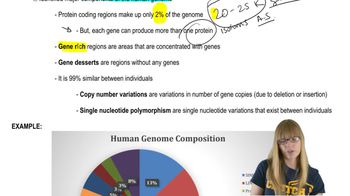A sufficient amount of a small DNA fragment is available for dideoxy sequencing. The fragment to be sequenced contains 20 nucleotides following the site of primer binding: 5'-ATCGCTCGACAGTGACTAGC-[primer site]-3' Dideoxy sequencing is carried out, and the products of the four sequencing reactions are separated by gel electrophoresis. Draw the bands you expect will appear on the gel from each of the sequencing reactions.
Table of contents
- 1. Introduction to Genetics51m
- 2. Mendel's Laws of Inheritance3h 37m
- 3. Extensions to Mendelian Inheritance2h 41m
- 4. Genetic Mapping and Linkage2h 28m
- 5. Genetics of Bacteria and Viruses1h 21m
- 6. Chromosomal Variation1h 48m
- 7. DNA and Chromosome Structure56m
- 8. DNA Replication1h 10m
- 9. Mitosis and Meiosis1h 34m
- 10. Transcription1h 0m
- 11. Translation58m
- 12. Gene Regulation in Prokaryotes1h 19m
- 13. Gene Regulation in Eukaryotes44m
- 14. Genetic Control of Development44m
- 15. Genomes and Genomics1h 50m
- 16. Transposable Elements47m
- 17. Mutation, Repair, and Recombination1h 6m
- 18. Molecular Genetic Tools19m
- 19. Cancer Genetics29m
- 20. Quantitative Genetics1h 26m
- 21. Population Genetics50m
- 22. Evolutionary Genetics29m
7. DNA and Chromosome Structure
DNA Structure
Problem 35
Textbook Question
Electrophoresis is an extremely useful procedure when applied to analysis of nucleic acids as it can resolve molecules of different sizes with relative ease and accuracy. Large molecules migrate more slowly than small molecules in agarose gels. However, the fact that nucleic acids of the same length may exist in a variety of conformations can often complicate the interpretation of electrophoretic separations. For instance, when a single species of a bacterial plasmid is isolated from cells, the individual plasmids may exist in three forms (depending on the genotype of their host and conditions of isolation): superhelical/supercoiled (form I), nicked/open circle (form II), and linear (form III). Form I is compact and very tightly coiled, with both DNA strands continuous. Form II exists as a loose circle because one of the two DNA strands has been broken, thus releasing the supercoil. All three have the same mass, but each will migrate at a different rate through a gel. Based on your understanding of gel composition and DNA migration, predict the relative rates of migration of the three DNA structures mentioned above.
 Verified step by step guidance
Verified step by step guidance1
Understand the relationship between DNA structure and migration rate: DNA migration in agarose gel electrophoresis is influenced by the size, shape, and conformation of the DNA molecule. Compact structures migrate faster because they experience less resistance from the gel matrix.
Analyze the three DNA conformations: Form I (supercoiled) is the most compact structure, Form II (nicked/open circle) is less compact due to the relaxed circular shape, and Form III (linear) is an intermediate structure in terms of compactness.
Predict the migration rate based on compactness: Since Form I is the most compact, it will migrate the fastest through the gel. Form III, being linear, will migrate slower than Form I but faster than Form II. Form II, being the least compact and most relaxed, will migrate the slowest.
Consider the gel composition: Agarose gel provides a porous matrix that separates DNA based on size and shape. The migration rates of the three forms are determined by how easily they can navigate through the gel's pores.
Summarize the relative migration rates: The order of migration from fastest to slowest is Form I (supercoiled), Form III (linear), and Form II (nicked/open circle). This prediction is based on the compactness and resistance each form experiences in the gel.
 Verified video answer for a similar problem:
Verified video answer for a similar problem:This video solution was recommended by our tutors as helpful for the problem above
Video duration:
2mPlay a video:
Was this helpful?
Key Concepts
Here are the essential concepts you must grasp in order to answer the question correctly.
Electrophoresis
Electrophoresis is a laboratory technique used to separate charged molecules, such as nucleic acids, based on their size and charge. In this process, an electric field is applied to a gel matrix, causing molecules to migrate through the gel. Smaller molecules move faster and travel further than larger ones, allowing for the resolution of different sizes. This technique is essential for analyzing DNA, RNA, and proteins in various biological studies.
Recommended video:
Guided course

Proteomics
DNA Conformations
DNA can exist in various conformations, which significantly affect its migration during electrophoresis. The three primary forms of plasmid DNA are supercoiled (form I), nicked/open circular (form II), and linear (form III). Supercoiled DNA is compact and migrates fastest due to its tight structure, while linear DNA migrates slower due to its extended form. Nicked DNA, being a relaxed circle, migrates at an intermediate rate, illustrating how conformation influences electrophoretic behavior.
Recommended video:
Guided course

DNA Proofreading
Agarose Gel Composition
Agarose gel is a common medium used in electrophoresis, composed of agarose polysaccharides that create a porous matrix. The concentration of agarose affects the gel's porosity, influencing the separation of nucleic acids based on size. Higher concentrations create smaller pores, which are better for resolving smaller fragments, while lower concentrations allow larger fragments to migrate more freely. Understanding gel composition is crucial for optimizing the separation of different DNA conformations.
Recommended video:
Guided course

Human Genome Composition
Related Videos
Related Practice
Textbook Question
484
views


